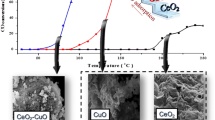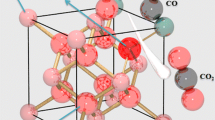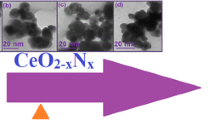Abstract
The size effect of ceria nanoparticles on surface oxygen mobility and formation of surface oxygen vacancies in ethanol steam reforming was investigated. Higher concentration of Ce3+ surface sites of the ceria nano-particles (~4 nm, NP) was observed compared to the micro-particles (~120 nm, MP). Similarly, studies using ambient-pressure X-ray photoelectron spectroscopy (AP-XPS) exhibited higher intensity of O1s assigned to the hydroxyl group bonding to Ce3+ and significantly lower intensity for lattice oxygen, stemming from an increase in the number of oxygen vacancies and enhanced oxygen mobility in the nano-ceria under ethanol steam reforming conditions. The presence of fully reduced cobalt particles (Coo) facilitated ceria reduction through hydrogen spillover. The comparison of cerium oxidation states between pre-reduced CeO2 and pre-reduced Co/CeO2 indicated higher extent of reduction of cerium in the case of Co/CeO2 for ethanol steam reforming. These results, together with our previous investigations where higher Ce3+ was observed over CeO2 compared to Co/CeO2 after pre-oxidation treatments, indicate that the initial state of cobalt in Co/CeO2 affects the oxidation state of cerium. Lastly, both nano-ceria and micro-ceria bare supports showed moderate C–C cleavage activities in ethanol steam reforming where better activity was observed over nano-ceria. Formate species were observed predominantly in the DRIFTS spectra of the nano-ceria whereas major species were acetates for micro-ceria. The dissimilarity in the reaction network was attributed to the difference in the number of surface oxygen vacancies. The Co/CeO2-NP catalyst was found more active compared to Co/CeO2-MP with higher hydrogen yield and ethanol conversion.
Graphical Abstract












Similar content being viewed by others
References
Trovarelli A, de Leitenburg C, Boaro M, Dolcetti G (1999) The utilization of ceria in industrial catalysis. Catal Today 50:353–367
Aneggi E, Boaro M, Colussi S, de Leitenburg C, Trovarelli A (2016) Ceria-Based Mater Catal 50:209–242
Zhang C, Michaelides A, King DA, Jenkins SJ (2009) Oxygen vacancy clusters on ceria: decisive role of ceriumfelectrons., Phys Rev B 79
Lan L, Chen S, Cao Y, Zhao M, Gong M, Chen Y (2015) Preparation of ceria-zirconia by modified coprecipitation method and its supported Pd-only three-way catalyst. J Colloid Interface Sci 450:404–416
Wang Q, Li G, Zhao B, Zhou R (2011) The effect of rare earth modification on ceria–zirconia solid solution and its application in Pd-only three-way catalyst. J Mol Catal A 339:52–60
Rodriguez JA, Grinter DC, Liu Z, Palomino RM, Senanayake SD (2017) Ceria-based model catalysts: fundamental studies on the importance of the metal-ceria interface in CO oxidation, the water-gas shift, CO2 hydrogenation, and methane and alcohol reforming., Chem Soc Rev 46:1824–1841
Colussi S, Katta L, Amoroso F, Farrauto RJ, Trovarelli A (2014) Ceria-based palladium zinc catalysts as promising materials for water gas shift reaction. Catal Commun 47:63–66
Vecchietti J, Bonivardi A, Xu W, Stacchiola D, Delgado JJ, Calatayud M, Collins SE (2014) Understanding the role of oxygen vacancies in the water gas shift reaction on ceria-supported platinum catalysts. ACS Catal 4:2088–2096
Dejhosseini M, Aida T, Watanabe M, Takami S, Hojo D, Aoki N, Arita T, Kishita A, Adschiri T (2013) Catalytic cracking reaction of heavy oil in the presence of cerium oxide nanoparticles in supercritical water. Energy Fuels 27:4624–4631
Golmohammadi M, Ahmadi SJ, Towfighi J (2016) Catalytic cracking of heavy petroleum residue in supercritical water: Study on the effect of different metal oxide nanoparticles. J Supercrit Fluids 113:136–143
Zhu B, Fan L, Lund P (2013) Breakthrough fuel cell technology using ceria-based multi-functional nanocomposites. Appl Energy 106:163–175
Fan L, Wang C, Chen M, Zhu B (2013) Recent development of ceria-based (nano)composite materials for low temperature ceramic fuel cells and electrolyte-free fuel cells. J Power Sour 234:154–174
Jiang T, Wang Z, Zhang J, Hao X, Rooney D, Liu Y, Sun W, Qiao J, Sun K, Hay R (2015) Understanding the flash sintering of rare-earth-doped ceria for solid oxide fuel cell. J Am Ceram Soc 98:1717–1723
Rico Pérez V, Ángeles M, Velasco Beltrán Q, He Q, Wang C, de Lecea CS, López AB (2013) Preparation of ceria-supported rhodium oxide sub-nanoparticles with improved catalytic activity for CO oxidation. Catal Commun 33:47–50
Ayodele BV, Khan MR, Cheng CK (2016) Catalytic performance of ceria-supported cobalt catalyst for CO-rich hydrogen production from dry reforming of methane. Int J Hydrogen Energy 41:198–207
Bayram B, Soykal II, von Deak D, Miller JT, Ozkan US (2011) Ethanol steam reforming over Co-based catalysts: Investigation of cobalt coordination environment under reaction conditions. J Catal 284:77–89
Song H, Ozkan US (2009) Changing the oxygen mobility in Co/Ceria catalysts by Ca incorporation: implications for ethanol steam reforming. J Phys Chem A 114:3796–3801
Soykal II, Sohn H, Ozkan US (2012) Effect of support particle size in steam reforming of ethanol over Co/CeO2 catalysts. ACS Catal 2:2335–2348
Li D, Zeng L, Li X, Wang X, Ma H, Assabumrungrat S, Gong J (2015) Ceria-promoted Ni/SBA-15 catalysts for ethanol steam reforming with enhanced activity and resistance to deactivation. Appl Catal B 176:532–541
Siang J-Y, Lee C-C, Wang C-H, Wang W-T, Deng C-Y, Yeh C-T, Wang C-B (2010) Hydrogen production from steam reforming of ethanol using a ceria-supported iridium catalyst: Effect of different ceria supports. Int J Hydrogen Energy 35:3456–3462
He Z, Wang X (2015) Renewable energy and fuel production over transition metal oxides: the role of oxygen defects and acidity. Catal Today 240:220–228
Dan M, Mihet M, Tasnadi-Asztalos Z, Imre-Lucaci A, Katona G, Lazar MD (2015) Hydrogen production by ethanol steam reforming on nickel catalysts: effect of support modification by CeO2 and La2O3. Fuel 147:260–268
Sharma YC, Kumar A, Prasad R, Upadhyay SN (2017) Ethanol steam reforming for hydrogen production: latest and effective catalyst modification strategies to minimize carbonaceous deactivation. Renew Sustain Energy Rev 74:89–103
Cifuentes B, Valero M, Conesa J, Cobo M (2015) Hydrogen production by steam reforming of ethanol on Rh-Pt catalysts: influence of CeO2, ZrO2, and La2O3 as supports. Catalysts 5:1872–1896
Divins NJ, Angurell I, Escudero C, Pérez-Dieste V, Llorca J (2014) Influence of the support on surface rearrangements of bimetallic nanoparticles in real catalysts. Science 346:620–623
Liu Z, Senanayake SD, Rodriguez JA (2016) Elucidating the interaction between Ni and CeOx in ethanol steam reforming catalysts: a perspective of recent studies over model and powder systems. Appl Catal B 197:184–197
Turczyniak S, Luo W, Papaefthimiou V, Ramgir NS, Haevecker M, Machocki A, Zafeiratos S (2015) A comparative ambient pressure X-ray photoelectron and absorption spectroscopy study of various cobalt-based catalysts in reactive atmospheres. Top Catal 59:532–542
Óvári L, Krick Calderon S, Lykhach Y, Libuda J, Erdőhelyi A, Papp C, Kiss J, Steinrück HP (2013) Near ambient pressure XPS investigation of the interaction of ethanol with Co/CeO2(111). J Catal 307:132–139
Liu Z, Duchon T, Wang H, Grinter DC, Waluyo I, Zhou J, Liu Q, Jeong B, Crumlin EJ, Matolin V, Stacchiola DJ, Rodriguez JA, Senanayake SD (2016) Ambient pressure XPS and IRRAS investigation of ethanol steam reforming on Ni-CeO2(111) catalysts: an in situ study of C–C and O–H bond scission. Phys Chem Chem Phys 18:16621–16628
Divins NJ, Llorca J (2016) In situ photoelectron spectroscopy study of ethanol steam reforming over RhPd nanoparticles and RhPd/CeO2. Appl Catal A 518:60–66
Sohn H, Soykal II, Zhang S, Shan J, Tao F, Miller JT, Ozkan US (2016) Effect of cobalt on reduction characteristics of ceria under ethanol steam reforming conditions: AP-XPS and XANES studies. J Phys Chem C 120:14631–14642
Soykal II, Sohn H, Singh D, Miller JT, Ozkan US (2014) Reduction characteristics of ceria under ethanol steam reforming conditions: effect of the particle size. ACS Catal 4:585–592
Tao FF (2012) Design of an in-house ambient pressure AP-XPS using a bench-top X-ray source and the surface chemistry of ceria under reaction conditions. Chem Commun 48:3812–3814
Shan J-j., Nguyen L, Zhang S, Tao F-F (2015) Water–gas shift on Pd/α-MnO2 and Pt/α-MnO2. Catal Lett 145:1571–1580
Boaro M, Vicario M, de Leitenburg C, Dolcetti G, Trovarelli A (2003) The use of temperature-programmed and dynamic/transient methods in catalysis: characterization of ceria-based, model three-way catalysts. Catal Today 77:407–417
Aliotta C, Liotta LF, La Parola V, Martorana A, Muccillo ENS., Muccillo R, Deganello F (2016) Ceria-based electrolytes prepared by solution combustion synthesis: the role of fuel on the materials properties. Appl Catal B 197:14–22
Wang Y, Liang S, Cao A, Thompson RL, Veser G (2010) Au-mixed lanthanum/cerium oxide catalysts for water gas shift. Appl Catal B 99:89–95
Abdelouahab-Reddam Z, El Mail R, Coloma F, Sepúlveda-Escribano A (2015) Platinum supported on highly-dispersed ceria on activated carbon for the total oxidation of VOCs., Appl Catal A 494:87–94
Moraes TS, Neto R.C.R., Ribeiro MC, Mattos LV, Kourtelesis M, Verykios X, Noronha FB (2015) Effects of ceria morphology on catalytic performance of Ni/CeO2 catalysts for low temperature steam reforming of ethanol. Top Catal 58:281–294
Rao GR, Mishra BG (2003) Structural, redox and catalytic chemistry of ceria based materials. Bull Catal Soc India 2:122–134
Xu J, Harmer J, Li G, Chapman T, Collier P, Longworth S, Tsang SC (2010) Size dependent oxygen buffering capacity of ceria nanocrystals. Chem Commun 46:1887–1889
Zhou X-D, Huebner W (2001) Size-induced lattice relaxation in CeO2 nanoparticles. Appl Phys Lett 79:3512–3514
Deshpande S, Patil S, Kuchibhatla SV, Seal S (2005) Size dependency variation in lattice parameter and valency states in nanocrystalline cerium oxide. Appl Phys Lett 87:133113
Liu X, Zhou K, Wang L, Wang B, Li Y (2009) Oxygen vacancy clusters promoting reducibility and activity of ceria nanorods. J Am Chem Soc 131:3140–3141
Naganuma T, Traversa E (2012) Stability of the Ce3+ valence state in cerium oxide nanoparticle layers. Nanoscale 4:4950–4953
Song W, Poyraz AS, Meng Y, Ren Z, Chen S-Y, Suib SL (2014) Mesoporous Co3O4 with controlled porosity: inverse micelle synthesis and high-performance catalytic CO oxidation at –60 °C. Chem Mater 26:4629–4639
Romar H, Lillebo AH, Tynjala P, Hu T, Holmen A, Blekkan EA, Lassi U (2016) H2-TPR, XPS and TEM study of the reduction of Ru and Re promoted Co/γ-Al2O3, Co/TiO2 and Co/SiC Catalysts. J Mater Sci Res 5:39
Lou Y, Wang L, Zhao Z, Zhang Y, Zhang Z, Lu G, Guo Y, Guo Y (2014) Low-temperature CO oxidation over Co3O4-based catalysts: significant promoting effect of Bi2O3 on Co3O4 catalyst. Appl Catal B 146:43–49
Song H, Ozkan US (2010) The role of impregnation medium on the activity of ceria-supported cobalt catalysts for ethanol steam reforming. J Mol Catal A 318:21–29
Luo J, Meng M, Li X, Li X, Zha Y, Hu T, Xie Y, Zhang J (2008) Mesoporous Co3O4–CeO2 and Pd/Co3O4–CeO2 catalysts: synthesis, characterization and mechanistic study of their catalytic properties for low-temperature CO oxidation. J Catal 254:310–324
Conner WC, Falconer JL (1995) Spillover in heterogeneous catalysis. Chem Rev 95:759–788
Sasikala R, Kulshreshtha SK (2004) Temperature programmed reduction studies of spillover effect in Pd impregnated metal oxide catalysts. J Therm Anal Calorim 78:723–729
Gao Y, Wang W, Chang S, Huang W (2013) Morphology effect of CeO2 support in the preparation, metal-support interaction, and catalytic performance of Pt/CeO2 catalysts. ChemCatChem 5:3610–3620
Song D, Li J (2006) Effect of catalyst pore size on the catalytic performance of silica supported cobalt Fischer–Tropsch catalysts. J Mol Catal A 247:206–212
Lira E, López CM, Oropeza F, Bartolini M, Alvarez J, Goldwasser M, Linares FL, Lamonier J-F, Zurita MJ (2008) HMS mesoporous silica as cobalt support for the Fischer–Tropsch synthesis: pretreatment, cobalt loading and particle size effects. J Mol Catal A 281:146–153
Varga E, Ferencz Z, Oszkó A, Erdőhelyi A, Kiss J (2015) Oxidation states of active catalytic centers in ethanol steam reforming reaction on ceria based Rh promoted Co catalysts: An XPS study. J Mol Catal A 397:127–133
Mei Z, Li Y, Fan M, Zhao L, Zhao J (2015) Effect of the interactions between Pt species and ceria on Pt/ceria catalysts for water gas shift: The XPS studies. Chem Eng J 259:293–302
Kato S, Ammann M, Huthwelker T, Paun C, Lampimaki M, Lee MT, Rothensteiner M, van Bokhoven JA (2015) Quantitative depth profiling of Ce(3+) in Pt/CeO2 by in situ high-energy XPS in a hydrogen atmosphere. Phys Chem Chem Phys 17:5078–5083
Jung Y, Yang W, Koo CY, Song K, Moon J (2012) High performance and high stability low temperature aqueous solution-derived Li–Zr co-doped ZnO thin film transistors. J Mater Chem 22:5390
Jain R, Dubey A, Ghosalya MK, Gopinath CS (2016) Gas–solid interaction of H2–Ce0.95Zr0.05O2: new insights into surface participation in heterogeneous catalysis. Catal Sci Technol 6:1746–1756
Younis A, Chu D, Kaneti YV, Li S (2016) Tuning the surface oxygen concentration of {111} surrounded ceria nanocrystals for enhanced photocatalytic activities. Nanoscale 8:378–387
Biesinger MC, Payne BP, Grosvenor AP, Lau LWM, Gerson AR, Smart RSC (2011) Resolving surface chemical states in XPS analysis of first row transition metals, oxides and hydroxides: Cr, Mn, Fe, Co and Ni, Appl Surf Sci 257:2717–2730
Domínguez M, Taboada E, Idriss H, Molins E, Llorca J (2010) Fast and efficient hydrogen generation catalyzed by cobalt talc nanolayers dispersed in silica aerogel. J Mater Chem 20:4875
Ernst B, Bensaddik A, Hilaire L, Chaumette P, Kiennemann A (1998) Study on a cobalt silica catalyst during reduction and Fischer–Tropsch reaction: in situ EXAFS compared to XPS and XRD. Catal Today 39:329–341
Li J, Xiong S, Li X, Qian Y (2012) Spinel Mn1.5Co1.5O4 core–shell microspheres as Li-ion battery anode materials with a long cycle life and high capacity. J Mater Chem 22:23254
Petitto SC, Marsh EM, Carson GA, Langell MA (2008) Cobalt oxide surface chemistry: the interaction of CoO(100), Co3O4(110) and Co3O4(111) with oxygen and water. J Mol Catal A 281:49–58
Jacobs G, Keogh R, Davis B (2007) Steam reforming of ethanol over Pt/ceria with co-fed hydrogen. J Catal 245:326–337
da Silva DCD, Letichevsky S, Borges LEP, Appel LG (2015) Elimination of acetaldehyde from hydrogen rich streams employing Ni/ZrO2. Int J Hydrogen Energy 40:8706–8712
Song H, Mirkelamoglu B, Ozkan US (2010) Effect of cobalt precursor on the performance of ceria-supported cobalt catalysts for ethanol steam reforming. Appl Catal A 382:58–64
Choong C, Zhong Z, Huang L, Borgna A, Hong L, Chen L, Lin J (2014) Infrared evidence of a formate-intermediate mechanism over Ca-modified supports in low-temperature ethanol steam reforming. ACS Catal 4:2359–2363
Sanchez-Sanchez MC, Navarro Yerga RM, Kondarides DI, Verykios XE, Fierro JLG (2009) Mechanistic aspects of the ethanol steam reforming reaction for hydrogen production on Pt, Ni, and PtNi catalysts supported on γ-Al2O3. J Phys Chem A 114:3873–3882
Yee A, Morrison S, Idriss H (1999) A study of the reactions of ethanol on CeO2 and Pd/CeO2 by steady state reactions, temperature programmed desorption, and in situ FT-IR. J Catal 186:279–295
Erdőhelyi A, Raskó J, Kecskés T, Tóth M, Dömök M, Baán K (2006) Hydrogen formation in ethanol reforming on supported noble metal catalysts. Catal Today 116:367–376
de Lima SM, Silva AM, da Cruz IO, Jacobs G, Davis BH, Mattos LV, Noronha FB (2008) H2 production through steam reforming of ethanol over Pt/ZrO2, Pt/CeO2 and Pt/CeZrO2 catalysts. Catal Today 138:162–168
Osorio-Vargas P, Campos CH, Navarro RM, Fierro JL, Reyes P (2015) Improved ethanol steam reforming on Rh/Al2O3 catalysts doped with CeO2 or/and La2O3: influence in reaction pathways including coke formation. Appl Catal A 505:159–172
Akdim O, Cai W, Fierro V, Provendier H, van Veen A, Shen W, Mirodatos C (2008) Oxidative steam reforming of ethanol over Ni–Cu/SiO2, Rh/Al2O3 and Ir/CeO2: effect of metal and support on reaction mechanism. Top Catal 51:22–38
Llorca J, Homs N, de la Piscina PR (2004) In situ DRIFT-mass spectrometry study of the ethanol steam-reforming reaction over carbonyl-derived Co/ZnO catalysts. J Catal 227:556–560
Acknowledgements
We gratefully acknowledge the US Department of Energy for the Grant DE-FG36-05GO15033 for our funding. The authors acknowledge Hendrik E. Colijn for his invaluable help in taking and analyzing the digital micrographs. F.T. acknowledges financial support from the NSF Career Award NSF-CHE-14162121, Chemical Sciences, Geosciences and Biosciences Division, Office of Basic Energy Sciences, Office of Science, U.S. Department of Energy, under Grant No. DE-SC0014561.
Author information
Authors and Affiliations
Corresponding authors
Rights and permissions
About this article
Cite this article
Sohn, H., Celik, G., Gunduz, S. et al. Oxygen Mobility in Pre-Reduced Nano- and Macro-Ceria with Co Loading: An AP-XPS, In-Situ DRIFTS and TPR Study. Catal Lett 147, 2863–2876 (2017). https://doi.org/10.1007/s10562-017-2176-4
Received:
Accepted:
Published:
Issue Date:
DOI: https://doi.org/10.1007/s10562-017-2176-4




